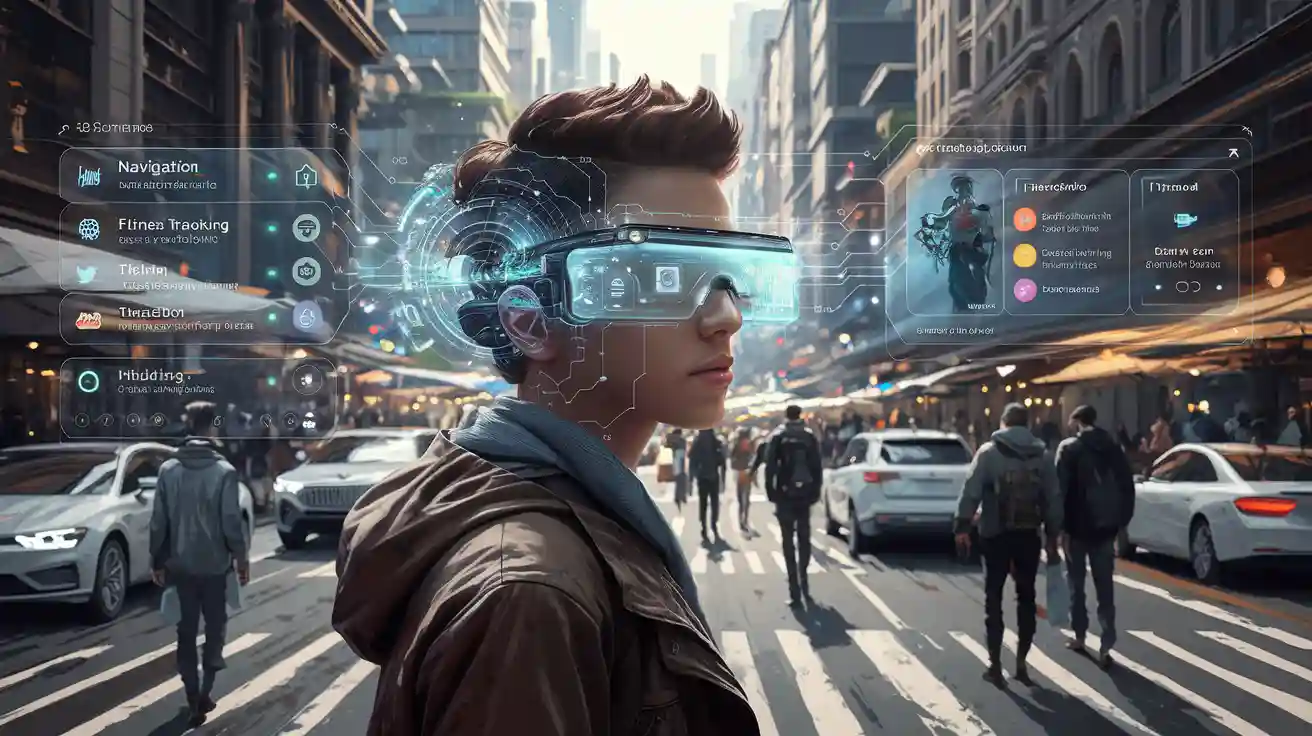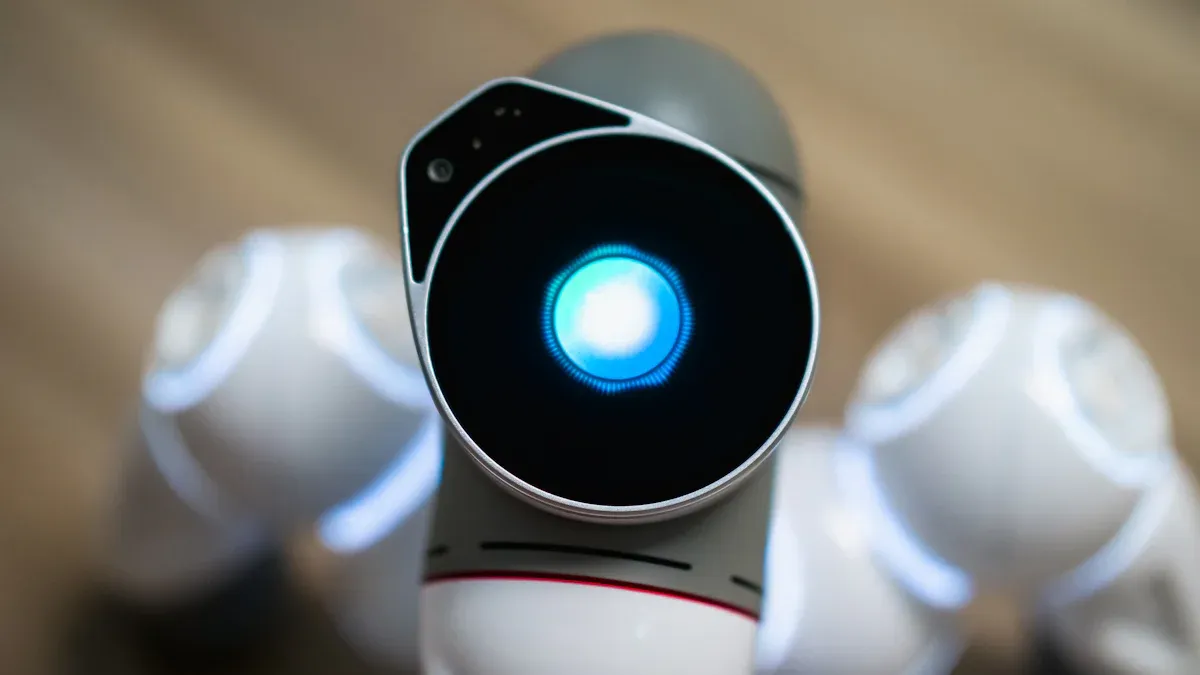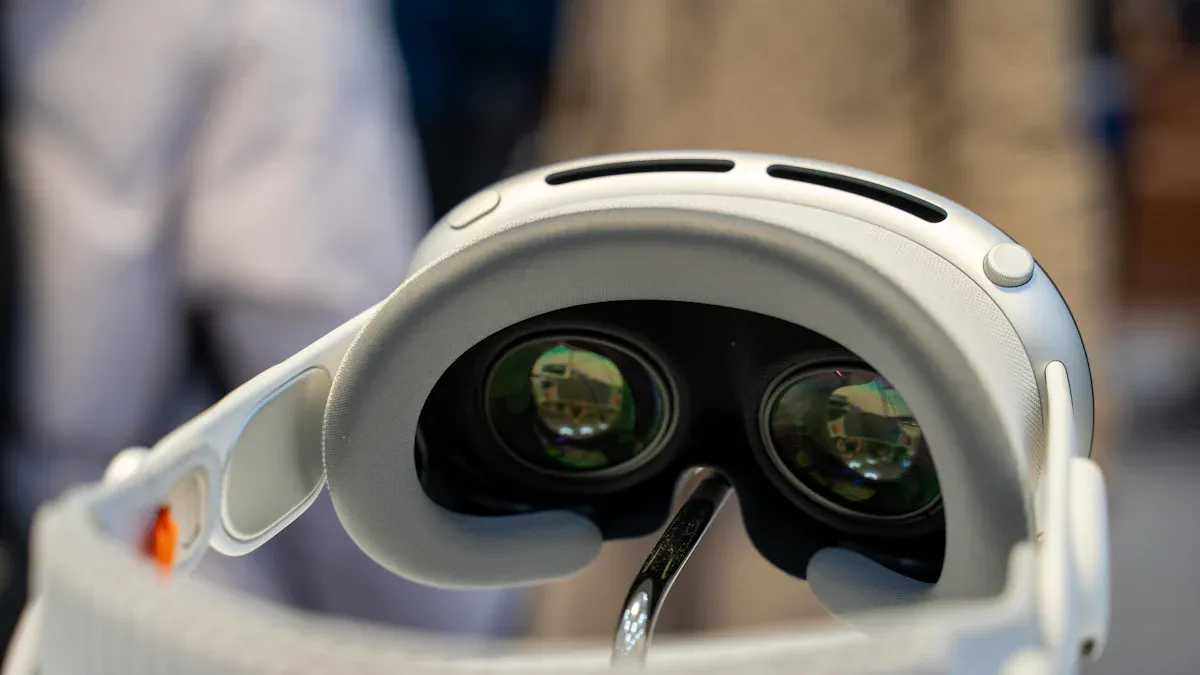
Imagine a world where your glasses do more than just improve your vision—they transform your daily life. AI smart glasses are making this a reality. These devices combine AI with cutting-edge technology to give you real-time assistance and personalized features. For instance, tools like NuEyes and Smart Vision Glasses help users with visual impairments enjoy activities like reading, cooking, and navigating safely. They even recognize faces and objects, boosting your independence and enhancing your experience in ways you never thought possible.
Key Takeaways
-
AI smart glasses help with daily tasks by giving quick help. They make things like reading and finding directions easier.
-
Augmented reality lets users connect with their surroundings. This helps them do more on their own and enjoy activities better.
-
Voice and hand controls make AI glasses easy to use. You can do things like get directions or translate without using your hands.
Key Features of AI-Powered Smart Glasses

Augmented Reality and Interactive Displays
Imagine walking into a room and instantly seeing helpful information about your surroundings displayed right in front of your eyes. That’s the magic of augmented reality in AI-powered smart glasses. These glasses overlay digital content onto the real world, creating an interactive experience that feels like something out of a sci-fi movie. Whether you’re navigating a busy city or learning a new skill, augmented reality makes tasks easier and more engaging.
For example, athletes can use these glasses to track their speed, distance, and heart rate in real time, helping them optimize their performance. The glasses also excel in facial recognition, processing up to 15 faces per frame in less than a second. This speed and accuracy make them invaluable for professionals and everyday users alike.
Here’s a quick look at how augmented reality features improve performance:
|
Metric |
Value |
|---|---|
|
Improvement in patient outcomes |
15% |
|
Reduction in average length of stay |
25% |
|
Increase in operating room utilization |
20% |
|
Faster decision-making in critical care |
30% |
|
Processing speed (facial recognition) |
Up to 15 faces per frame in < 1 second |
|
Real-time performance metrics (athletes) |
Speed, distance, heart rate |
With augmented reality, you’re not just seeing the world—you’re interacting with it in ways that enhance your life and independence.
Real-Time AI Assistance and Data Processing
AI-powered smart glasses don’t just show you information; they process it in real time to provide meaningful assistance. These glasses analyze your surroundings, understand your context, and deliver insights that make your day smoother. For instance, if you’re visually impaired, the glasses can identify objects, read text aloud, and even guide you through unfamiliar spaces.
The technology behind this is impressive. Systems like AiGet use multimodal data processing to reduce cognitive load and keep you focused on what matters. They employ parallel processing to speed up decision-making, ensuring you get the information you need without delay. In fact, in-lab tests show that these systems uncover hidden interests and enhance enjoyment of primary tasks, making them perfect for both work and leisure.
Other innovations, like ElectraSight, take data processing to the next level. ElectraSight achieves a classification accuracy of 92% for basic eye movements and processes data in just 301 microseconds. This efficiency means you can rely on your glasses for continuous use, with a battery life of up to three days.
These features aren’t just about convenience—they’re about empowering you to live a more connected and productive life.
Voice, Gesture, and Command Controls
Controlling your AI glasses is as simple as speaking or moving your hand. Voice and gesture controls make these devices incredibly intuitive, allowing you to interact with them without breaking your flow. Whether you’re giving a voice command to check the weather or using a hand gesture to zoom in on a map, the glasses respond quickly and accurately.
The gesture recognition model used in these glasses boasts an impressive accuracy of 96.8%, even in complex environments. Under ideal conditions, the accuracy reaches 100%, making it one of the most reliable systems available. The glasses perform best at a distance of about two meters, ensuring smooth operation in everyday scenarios.
Voice-controlled assistance is another standout feature. You can ask your glasses to perform tasks like translating languages, reading text, or even providing navigation directions. This hands-free functionality is especially helpful for people with mobility challenges or those who need assistive technology to enhance accessibility.
With voice and gesture controls, you’re not just using technology—you’re commanding it to fit seamlessly into your life.
Practical Applications of AI Smart Glasses
Navigation and Real-Time Wayfinding
Imagine walking through a crowded city or exploring a new neighborhood without worrying about getting lost. AI smart glasses make this possible by offering real-time wayfinding and navigation assistance. These glasses use advanced neural networks to detect spatial targets and predict optimal paths, ensuring you reach your destination efficiently.
Here’s how they excel:
-
They combine visual and auditory cues to guide you through unfamiliar environments.
-
Their sensing range spans 10–20 meters, giving you ample time to react to obstacles.
-
Localization errors are minimal, with accuracy within one meter.
|
Metric |
Success Rate/Accuracy |
|---|---|
|
Target Detection Success Rate |
|
|
Optimal Path Prediction Success Rate |
92.60% |
|
ISANA Localization Error |
< 1 m |
|
Average Navigation Guidance Error |
Decreased significantly |
|
Sensing Range |
10–20 m |
These features are especially helpful for visually impaired individuals, as the glasses provide intelligent assistance to navigate safely and independently. Whether you’re commuting to work or exploring a new city, AI glasses make every journey smoother and more enjoyable.
Tip: Pair your AI glasses with voice assistant integration for hands-free navigation. It’s like having a personal guide wherever you go!
Accessibility for Sensory Impairments
AI smart glasses are transforming the assistive technology landscape, offering enhanced accessibility for individuals with sensory impairments. If you’re visually impaired, these glasses can read text aloud, identify faces, and even alert you to obstacles in real time. For deaf individuals, they provide immersive experiences through real-time speech-to-text translation, bridging communication gaps effortlessly.
Here’s what makes them stand out:
-
Facial Recognition: They identify people and provide spoken alerts, boosting your confidence in social settings.
-
Text-to-Speech Technology: Printed and digital text becomes accessible, whether you’re shopping or navigating public transportation.
-
Navigation Assistance: GPS integration offers step-by-step voice directions, ensuring you move safely through unfamiliar spaces.
-
Enhanced Mobility: Real-time feedback about surroundings keeps you safe in crowded areas.
-
Shopping Independence: You can read price tags and product labels without needing help.
These features empower you to live a more independent life, making everyday tasks easier and more accessible. AI-powered voice assistants further enhance accessibility, allowing you to interact with your glasses using simple voice commands.
Note: These glasses are a game-changer for the visually impaired and deaf individuals, offering intelligent assistance that adapts to your needs.
Enhancing Communication and Translation
Language barriers can feel overwhelming, but AI glasses are here to help. With real-time speech-to-text translation, you can communicate effortlessly in diverse settings. Whether you’re in a classroom, a meeting, or traveling abroad, these glasses ensure you stay connected and engaged.
For example, Ray-Ban Meta glasses translate languages like English and Spanish in real time, making them ideal for multilingual environments. Students benefit from improved accessibility, participating fully in lessons without missing key points. Teachers also appreciate the enhanced engagement these glasses bring to the classroom.
However, there’s room for improvement. While basic conversations are translated effectively, faster speech and slang can pose challenges. Mixed-language dialogues, like Spanglish, sometimes yield mixed results. Despite these limitations, the glasses continue to refine their capabilities through user feedback, ensuring they meet your needs better over time.
Callout: Real-time translation isn’t just about understanding words—it’s about connecting with people and experiencing the world in new ways.
AI glasses are reshaping communication, making it easier for deaf individuals and those navigating multilingual spaces to interact confidently. With ongoing advancements, these devices promise even more immersive experiences in the future.
Impact of AI Glasses on Daily Life

Boosting Independence and Confidence
AI glasses are a game-changer when it comes to boosting your independence. If you’re visually impaired, these devices can help you navigate the world with confidence. They identify objects, read text aloud, and even recognize faces, making social interactions less stressful. Imagine walking into a room and instantly knowing who’s there or reading a menu without asking for help. These features empower you to take control of your daily life.
For those with mobility challenges, voice-controlled assistance makes tasks easier. You can give simple commands to get directions, check the weather, or even translate languages. This hands-free functionality ensures you stay independent while managing everyday activities. With AI smart glasses, you’re not just living—you’re thriving.
Tip: Use the augmented reality features to explore new places with ease. It’s like having a personal guide by your side!
Improving Productivity and Efficiency
AI glasses don’t just make life easier—they make you more productive. In industries like manufacturing and logistics, these devices streamline tasks and improve efficiency. For example, companies like DHL have reported faster order deliveries thanks to AI-powered glasses. In healthcare, they verify medication labels in real time, reducing errors and saving lives.
Here’s a quick look at how different industries benefit:
|
Industry |
Improvement Description |
|---|---|
|
Manufacturing |
Smart glasses enhance worker efficiency and operational performance, particularly in warehouse picking and assembly. |
|
Logistics |
Companies like DHL have reported significant improvements in order delivery times due to the use of smart glasses. |
|
Construction |
These devices improve safety by highlighting dangers and providing instant access to data, leading to quicker task completion. |
|
Healthcare |
Smart glasses facilitate remote consultations and diagnostics, improving care quality in underserved areas. |
In your daily routine, these glasses can help you multitask like a pro. They detect vial swap errors with 99.6% accuracy and streamline hospital billing, reducing costs and mistakes. Whether you’re at work or home, AI glasses keep you efficient and focused.
Enhancing Safety in Everyday Activities
Safety is a top priority, and AI glasses excel in this area. They provide real-time feedback about your surroundings, helping you avoid obstacles and stay safe. For the visually impaired, this assistive technology is invaluable. It alerts you to potential hazards, ensuring you move through crowded spaces with ease.
In construction, these glasses highlight dangers like exposed wires or unstable surfaces, reducing accidents. For drivers, they offer navigation assistance and warn about nearby vehicles, making roads safer for everyone. With AI glasses, you can tackle daily challenges with peace of mind.
Callout: AI glasses aren’t just tools—they’re your safety net, helping you navigate life with confidence.
AI smart glasses are reshaping how you experience the world. They combine assistive features with cutting-edge AI to enhance independence and engagement. With market growth projected at 48% annually by 2030 and sales reaching 13.3 million units, this inclusive technology is driving user empowerment and fostering life-changing inclusion.
Note: As AI glasses evolve, they promise a future filled with smarter, more connected possibilities.
FAQ
What are AI glasses, and how do they work?
AI glasses are wearable devices that use artificial intelligence to assist you. They process data in real time, offering features like navigation, object recognition, and hands-free operation.
Can AI glasses improve accessibility for visually impaired users?
Yes! AI glasses read text aloud, identify faces, and provide navigation assistance. They offer a hands-free experience, empowering visually impaired individuals to navigate the world confidently.
Are AI glasses easy to use for beginners?
Absolutely! AI glasses feature intuitive controls like voice commands and gestures. These make them user-friendly, ensuring you enjoy a seamless, hands-free experience from day one.
